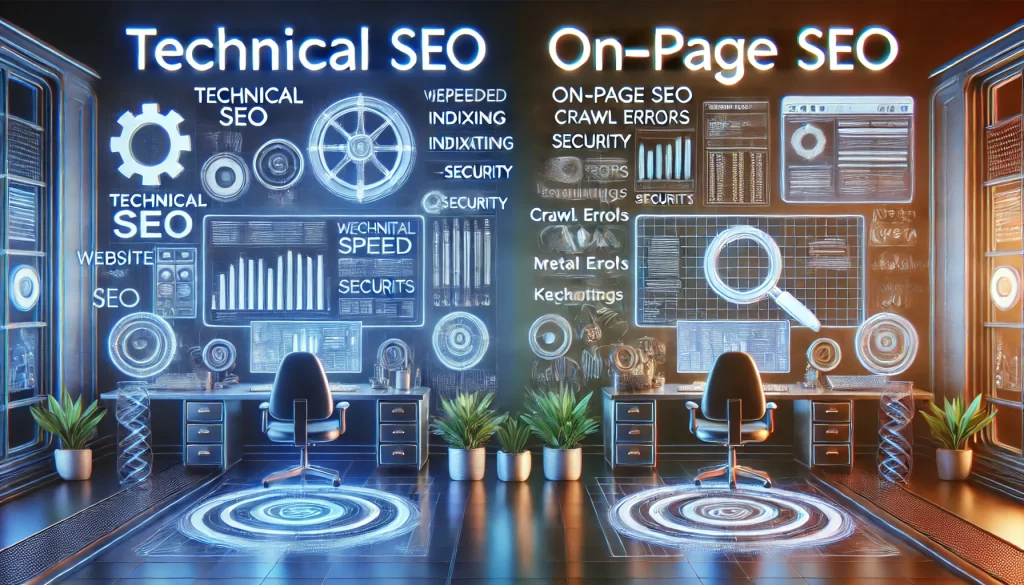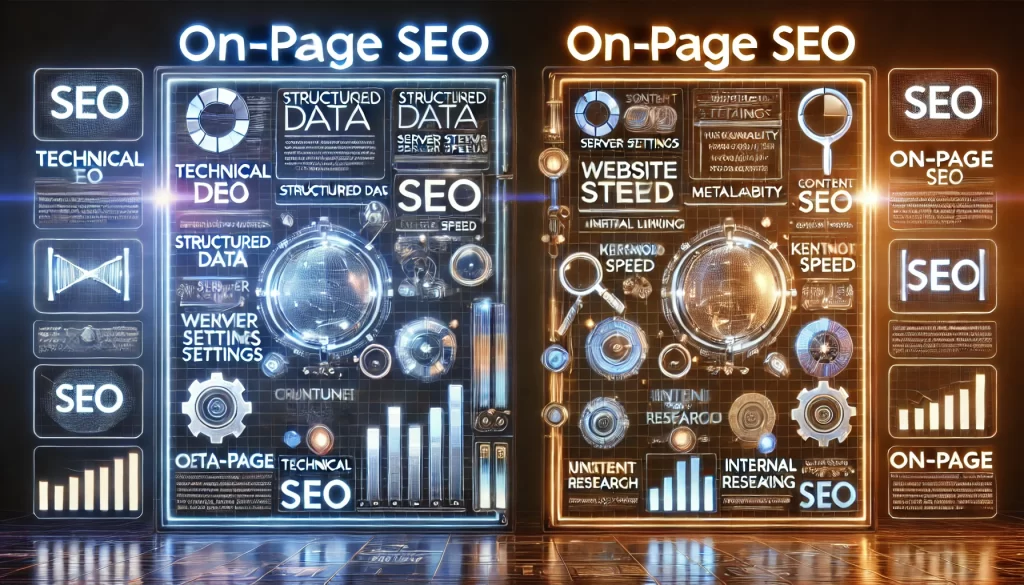SEO consists of multiple strategies, but two of the most critical components are technical SEO and on-page SEO. While both contribute to higher search rankings, they focus on different aspects of website optimization.
✔ Technical SEO → Improves website structure, speed, and crawlability for better indexing.
✔ On-Page SEO → Optimizes content, keywords, and user experience for better search rankings.
A successful SEO strategy requires both technical and on-page SEO. Let’s break down their differences, importance, and how to audit them.

Technical SEO vs. On-Page SEO
| Factor | Technical SEO | On-Page SEO |
| Focus Area | Website structure & backend optimization | Content & user experience |
| Goal | Improve crawling, indexing, and site speed | Enhance content relevance & keyword optimization |
| Optimization Techniques | Site speed, mobile usability, structured data | Titles, meta descriptions, content structure |
| Importance | Ensures search engines can access your site | Ensures users find relevant & engaging content |
💡 Best Practice: Start with technical SEO first (to ensure Google can crawl your site), then optimize on-page SEO for better content ranking.
Related Posts
How to Perform a Technical SEO Audit (Step-by-Step Guide)
Step 1: Check Website Crawlability & Indexing
🔹 Use Google Search Console → Inspect indexing errors & crawl issues
🔹 Ensure the robots.txt file isn’t blocking important pages
🔹 Submit an updated XML sitemap
✅ Fix: Remove crawl errors, improve site structure
Step 2: Analyze Page Speed & Core Web Vitals
🔹 Test site performance with Google PageSpeed Insights
🔹 Optimize image sizes, reduce server response time, enable caching
✅ Fix: Improve load speed for better rankings & user experience
Step 3: Optimize Mobile Usability & Security
🔹 Use Google Mobile-Friendly Test
🔹 Ensure the site is responsive & SSL-secured (HTTPS)
✅ Fix: Implement mobile-friendly design & security best practices

How to Perform an On-Page SEO Audit (Step-by-Step Guide)
Step 1: Optimize Titles, Meta Descriptions & Headings
🔹 Ensure unique & keyword-rich meta titles & descriptions
🔹 Use H1, H2, and H3 headers for proper content hierarchy
✅ Fix: Improve metadata for better click-through rates (CTR)
Step 2: Improve Content Quality & Keyword Optimization
🔹 Check for thin, duplicate, or outdated content
🔹 Optimize pages with primary & LSI keywords
✅ Fix: Update existing content for better engagement
Step 3: Strengthen Internal Linking & User Experience
🔹 Use descriptive anchor text for internal links
🔹 Ensure navigation is intuitive & user-friendly
✅ Fix: Improve internal linking strategy to boost page authority
Related Posts
Which One Matters More: Technical SEO or On-Page SEO?
🚀 Both are equally important!
- Without technical SEO, search engines can’t crawl & index your content.
- Without on-page SEO, even indexed pages won’t rank well.
💡 Best Practice: Conduct regular audits for both to maintain SEO health & visibility.
FAQs About Technical SEO vs. On-Page SEO
Can I focus only on one type of SEO?
No! Both are essential for search rankings.
Which should I fix first: technical SEO or on-page SEO?
Start with technical SEO (crawlability issues), then on-page SEO.
How often should I audit my technical and on-page SEO?
Technical SEO: Every 3-6 months, On-page SEO: Every 6-12 months.
Key Takeaways
Technical SEO vs. On-Page SEO
✔ Technical SEO ensures search engines can crawl & index your site.
✔ On-page SEO helps your content rank & engage users.
✔ Both are critical for long-term search engine success.
If you want higher rankings & better SEO performance, optimize both technical and on-page SEO!
Next Step?
Need a professional SEO audit to improve technical & on-page SEO?📩 Request a Free SEO Audit
